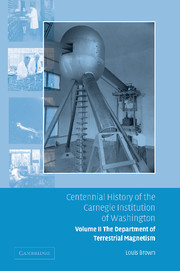Book contents
- Frontmatter
- Contents
- Foreword by Richard A. Meserve
- Preface
- 1 Establishment
- 2 Cruises and war
- 3 Expeditions
- 4 Measurements: magnetic and electric
- 5 The Fleming transition
- 6 The last cruise
- 7 The magnetic observatories and final land observations
- 8 The ionosphere
- 9 Collaboration and evaluation
- 10 The Tesla coil
- 11 The Van de Graaff accelerator
- 12 The nuclear force
- 13 Fission
- 14 Cosmic rays
- 15 The proximity fuze and the war effort
- 16 The Tuve transition
- 17 Postwar nuclear physics
- 18 The cyclotron
- 19 Biophysics
- 20 Explosion seismology
- 21 Isotope geology
- 22 Radio astronomy
- 23 Image tubes
- 24 Computers
- 25 Earthquake seismology
- 26 Strainmeters
- 27 The Bolton and Wetherill years
- 28 Astronomy
- 29 The solar system
- 30 Geochemistry
- 31 Island-arc volcanoes
- 32 Seismology revisited
- 33 Geochemistry and cosmochemistry
- 34 The Solomon transition
- 35 The support staff
- 36 Epilogue
- Notes
- Index
21 - Isotope geology
Published online by Cambridge University Press: 06 January 2010
- Frontmatter
- Contents
- Foreword by Richard A. Meserve
- Preface
- 1 Establishment
- 2 Cruises and war
- 3 Expeditions
- 4 Measurements: magnetic and electric
- 5 The Fleming transition
- 6 The last cruise
- 7 The magnetic observatories and final land observations
- 8 The ionosphere
- 9 Collaboration and evaluation
- 10 The Tesla coil
- 11 The Van de Graaff accelerator
- 12 The nuclear force
- 13 Fission
- 14 Cosmic rays
- 15 The proximity fuze and the war effort
- 16 The Tuve transition
- 17 Postwar nuclear physics
- 18 The cyclotron
- 19 Biophysics
- 20 Explosion seismology
- 21 Isotope geology
- 22 Radio astronomy
- 23 Image tubes
- 24 Computers
- 25 Earthquake seismology
- 26 Strainmeters
- 27 The Bolton and Wetherill years
- 28 Astronomy
- 29 The solar system
- 30 Geochemistry
- 31 Island-arc volcanoes
- 32 Seismology revisited
- 33 Geochemistry and cosmochemistry
- 34 The Solomon transition
- 35 The support staff
- 36 Epilogue
- Notes
- Index
Summary
There can be no satisfactory knowledge of when humankind began to wonder about the age of the Earth, but given the multitude of answers proffered in the world's religions and myths, one must assume it was very early. Answers supported by some kind of objective questioning of the evidence observed in the Earth and the solar system are, however, relatively recent, dating from the Age of the Enlightenment. In 1748 conjectures by Benoit de Maillet from (wrong) interpretations of fossil evidence contradicted the biblical periods, indeed suggesting an age of 2.4 billion years. Numerous attempts were made during the following century and a half based on the cooling of the Earth and Sun, solar orbital physics, ocean chemistry, erosion and sedimentation. The only common element of these attempts was that all were orders of magnitude greater than what was found in Genesis. The discovery of radioactivity at the end of the nineteenth century altered things substantially in the minds of the investigators of the time by providing a method for determining the ages of rocks and by disposing of Kelvin's age estimates, which had been derived from erroneous assumptions calling for much shorter ages than geology required. Radioactivity provided a heat source within the Earth, and presumably within the Sun, that evaded the heat flow problem.
The recognition that radioactivity was the key to terrestrial age determinations did not circumvent the problems of using it, problems that would not be surmounted for half a century.
- Type
- Chapter
- Information
- Centennial History of the Carnegie Institution of Washington , pp. 157 - 162Publisher: Cambridge University PressPrint publication year: 2005



